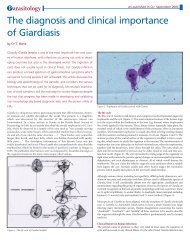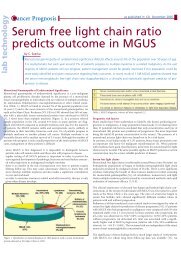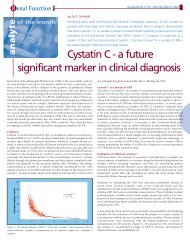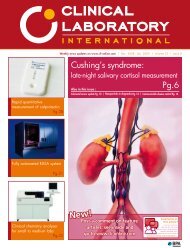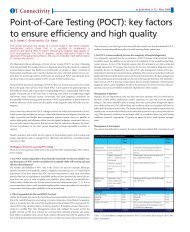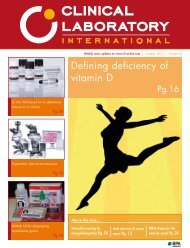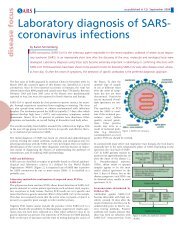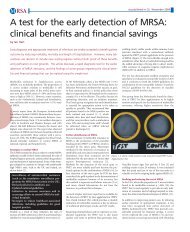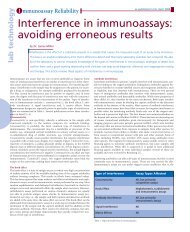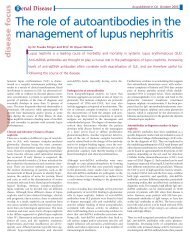One micron magnetic beads optimised for automated immunoassays
One micron magnetic beads optimised for automated immunoassays
One micron magnetic beads optimised for automated immunoassays
You also want an ePaper? Increase the reach of your titles
YUMPU automatically turns print PDFs into web optimized ePapers that Google loves.
I mmunodiagnostics<br />
As Published in CLI April 2005<br />
Figure 2. Hysteresis curve <strong>for</strong> the bead plat<strong>for</strong>m: magnetisation as a function<br />
of <strong>magnetic</strong> field strength. The magnetisation curves are overlapping<br />
both when increasing and decreasing the <strong>magnetic</strong> field, and the <strong>beads</strong><br />
show superpara<strong>magnetic</strong> behaviour.<br />
Figure 3. Sedimentation of 1.0 µm and 2.8 µm <strong>beads</strong> in aqueous solution<br />
measured as relative absorbance at 450 nm as a function of settling<br />
time (minutes).<br />
urement is dependent on bead diameter since the volume of the<br />
bead is proportional to the cube of the radius.<br />
Magnetic properties<br />
The <strong>magnetic</strong> properties of <strong>beads</strong> used as the solid phase in<br />
<strong>automated</strong> systems are clearly of great importance, both during<br />
the manufacture of the immunoassay and in its application. To<br />
ensure that the <strong>beads</strong> are collected efficiently on the magnet the<br />
iron oxide content must be high. However, total resuspension of<br />
the pellet during washing steps is equally important as rapid,<br />
effective washing steps reduce assay time and there<strong>for</strong>e increase<br />
overall throughput. To satisfy these requirements the <strong>beads</strong><br />
must be truly superpara<strong>magnetic</strong> and there should be no remanence<br />
after removing the <strong>magnetic</strong> field.<br />
The iron oxide content of Dyna<strong>beads</strong> My<strong>One</strong> <strong>beads</strong> is 37%. The<br />
<strong>magnetic</strong> material is evenly distributed throughout the <strong>beads</strong> as<br />
nanosized iron oxide crystals. This results in superpara<strong>magnetic</strong><br />
behaviour, as shown by the hysteresis curve in Figure 2, where<br />
the magnetisation is nearly identical with both increasing and<br />
decreasing <strong>magnetic</strong> fields. The <strong>beads</strong> show no remanence<br />
when the <strong>magnetic</strong> field is zero.<br />
Surface characteristics<br />
Hydrophobicity and the charge on the bead surface are important<br />
parameters when coating <strong>beads</strong> with antibodies or similar<br />
proteins generally needed in <strong>immunoassays</strong>. The initial driving<br />
Table 1. Relative contact angle and isoelectric point measured with Zeta potential.<br />
<strong>for</strong>ce when immobilising antibodies on hydrophobic <strong>beads</strong>,<br />
such as the tosylactivated <strong>beads</strong>, is hydrophobic adsorption to<br />
the bead surface. The chemical covalent bonds between the<br />
tosylactivated groups on the bead surface and the protein are<br />
only created after this initial contact. For hydrophilic bead surfaces<br />
the initial contact between the antibody and the surface<br />
of the bead is electrostatic or via random interactions, or it<br />
may occur following activation of functional groups on the<br />
bead surface.<br />
The degree of hydrophobicity of the tosylactivated <strong>beads</strong> as well<br />
as the carboxylic acid version of the <strong>beads</strong> was determined by<br />
measuring the contact angle of water droplets deposited on a<br />
layer of dry <strong>beads</strong> using a Fibro Dat 1120 instrument (Thwing-<br />
Albert Instrument Company, USA). The higher the contact<br />
angle observed, the more hydrophobic the bead surface.<br />
The isoelectric point <strong>for</strong> each of the bead types was also determined<br />
using the Zetasizer 2000-3000 HS (Malvern<br />
Instruments, UK) to measure the Zeta potential. These measurements<br />
were per<strong>for</strong>med on uncoated <strong>beads</strong> as well as on<br />
<strong>beads</strong> coated with antibody or streptavidin, to assess whether<br />
the surface properties of the <strong>beads</strong> are affected by the immobilised<br />
protein. The results are shown in Table 1.<br />
The hydrophobicity of the tosylactivated <strong>beads</strong> is very comparable,<br />
whereas the carboxylic acid <strong>beads</strong> are, in contrast, very<br />
hydrophilic due to their high negative<br />
net charge at neutral pH. Zeta potential<br />
measurements were per<strong>for</strong>med on three<br />
different types of <strong>beads</strong> (two sizes of<br />
tosylactivated <strong>beads</strong> and carboxylic acid<br />
<strong>beads</strong>) after coating with monoclonal<br />
mouse IgG1 antibody and streptavidin<br />
[Table 1]. These results show that the<br />
isoelectric point of the <strong>beads</strong> is principally<br />
determined by the nature of the<br />
immobilised protein. For example, after<br />
coating the originally negatively charged<br />
carboxylic acid <strong>beads</strong> with antibody,<br />
their isoelectric point is similar to the<br />
more neutral tosylactivated <strong>beads</strong> coated<br />
with the same antibody.



